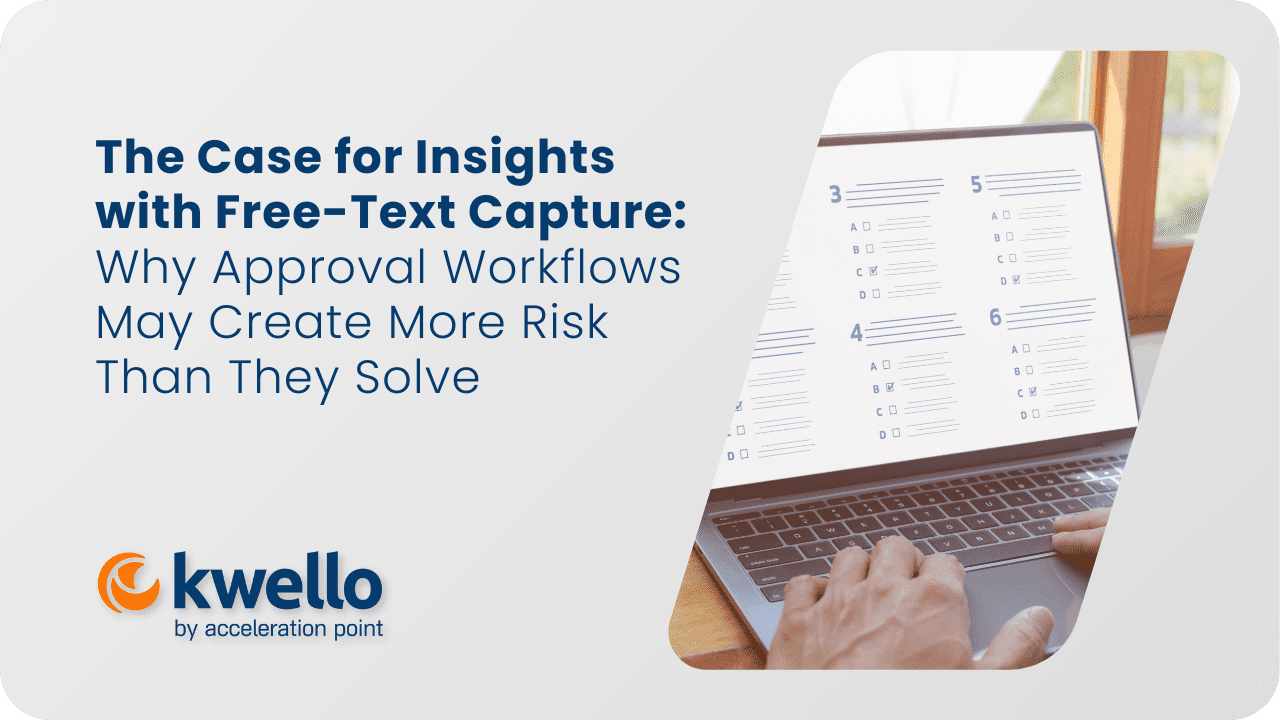For pharmaceutical companies, capturing insights from KOL interactions is essential for shaping medical and commercial strategies. However, some organizations have implemented multi-step approval workflows for insight capture, requiring layers of review before an insight is made visible.
While these workflows may seem like a compliance safeguard, they introduce significant risks—delaying decision-making, reducing the volume of captured insights, and even creating compliance vulnerabilities if insights are altered before approval.
In one large pharma company we spoke with, an insight had to be approved by:
-
- The field team member’s manager
- The country manager
- The regional manager
- The global insights manager
The result? Thousands of insights sat in backlog for months, making them outdated and ineffective.
For leaders of teams capturing insights—including Medical Affairs and Commercial—the key question is:
Does an approval workflow truly mitigate compliance risks, or does it create new ones?
This article explores:
-
- Why approval workflows don’t add meaningful compliance protection
- How they actually introduce compliance risks
- A smarter approach to balancing compliance with efficiency
Why Pre-Approval Workflows Do Not Improve Compliance
The primary argument for approval workflows is that they help prevent compliance risks related to:
-
- Pharmacovigilance (PV) & adverse event (AE) reporting
- Promotional boundaries & non-compliant communication
- Data privacy & regulatory concerns
However, in practice, these risks are already managed through existing compliance safeguards, making additional layers of approval redundant.
Pharmacovigilance (PV) & AE Reporting Already Have Established Processes
-
- Field teams are trained on AE & PV reporting. Teams already know how to escalate potential AEs—this is standard practice. Insight capture is separate from PV reporting.
- AI-driven compliance checks assist without blocking insights. Some organizations use AI within their capture tools to flag potential compliance risks (e.g., AE-related language) and alert the user for review before submission.
Data Privacy & Regulatory Compliance Are Already Built In
-
- Insights do not contain patient-identifiable data. Insight capture focuses on scientific and strategic observations, not personal health data.
- Platforms already follow compliance frameworks. Secure systems ensure insights remain within legal and regulatory guidelines.
Promotional Compliance Is Addressed Through Role-Specific Guardrails
-
- Medical and Commercial teams operate under separate compliance rules. Insights are already governed by clear role-based compliance policies, ensuring that promotional boundaries are not crossed.
- Role-based access prevents misuse. Insights are typically only visible to relevant teams, preventing inappropriate use across functions.
Since these safeguards are already in place, requiring manual approval for every insight provides no additional compliance benefit.
The Compliance Risks of Approval Workflows
While approval workflows are intended to reduce risk, they may introduce several compliance vulnerabilities, including:
Compliance Risk: Altering Insights Post-Capture
One overlooked risk of approval workflows is that managers reviewing insights may modify them before approval. This can lead to:
-
- Misrepresentation of KOL feedback – If an insight is changed to align with internal priorities rather than reflecting what was actually said, this creates a bias risk.
- Scientific & regulatory risk – In Medical Affairs, accuracy in scientific exchange is critical. If an insight is edited without clear documentation, it could be problematic in compliance audits.
- Auditability issues – Regulatory bodies expect transparency in how insights are gathered. If there is no version control or attribution for edits, the integrity of the insight is compromised.
Compliance Risk: Delayed or Lost Insights
-
- Approval backlogs create a risk of outdated or missing data. If insights sit in review queues for weeks or months, they may no longer be actionable, leading to missed opportunities and uninformed decision-making.
- Regulators expect timely response to insights. For insights related to patient safety, medical strategy, or compliance concerns, a delay could result in regulatory scrutiny if organizations cannot demonstrate they acted promptly.
Compliance Risk: Reducing Insight Capture Rates
-
- Approval barriers discourage field teams from capturing insights at all. If teams know their insights will face heavy scrutiny or slow approvals, they may choose not to record them in the first place—leading to gaps in intelligence.
- Incomplete insight collection can create a biased view of KOL interactions. Regulators and internal stakeholders rely on comprehensive insight collection. If only “safe” or pre-approved insights are captured, the dataset is no longer fully representative, leading to potential misalignment in strategy.
A Smarter Approach: Compliance Without Bureaucracy
Instead of manual approval workflows, organizations should focus on real-time compliance safeguards that ensure accuracy without causing delays.
-
- AI-Powered Compliance Checks – AI-driven alerts can flag potential PV risks or non-compliant language while still allowing real-time insight capture.
- Post-Capture Compliance Audits – Instead of pre-approvals, regular compliance reviews (e.g., monthly audits) ensure adherence without slowing down insight flow.
- Clear Role-Based Access & Firewalls – Ensuring that insights stay within the right teams prevents cross-functional compliance concerns.
- Transparent Version Control – If insights must be edited, maintaining an audit trail ensures compliance integrity.
Conclusion: Approval Workflows Create More Compliance Risks Than They Solve
While compliance is critical, pre-approval workflows are not the answer. Instead of mitigating risks, they introduce delays, create compliance vulnerabilities, and discourage accurate insight capture.
By shifting to real-time compliance safeguards, post-capture audits, and AI-driven risk detection, organizations can ensure insights remain compliant, timely, and actionable—without unnecessary bottlenecks.
Next Steps for Leaders:
-
- Assess your current insight workflow—are approvals creating unnecessary delays?
- Engage compliance teams to discuss AI-driven monitoring instead of manual reviews.
- Ensure that insight capture is enabling, not hindering, strategic decision-making.
It’s time for pharma companies to modernize insight capture—without compromising compliance.
Schedule a meeting with our team to learn more about our approach to insights.

